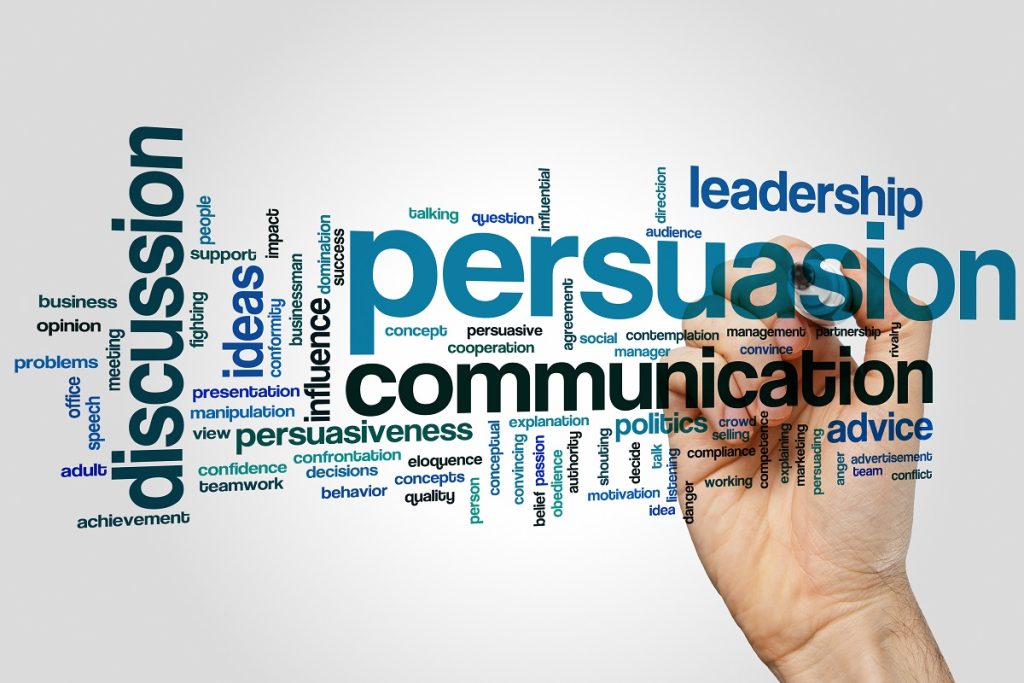A persuasive speech is a type of speech that is designed to convince the audience to believe or do something. In contrast to an informative speech that presents facts, values, and policies, the goal of a persuasive speech is to use these elements to change the audience’s mind on a particular issue.
In a nutshell, a persuasive speech is a speaker’s attempt to convince the audience to believe their point of view.
You might associate it with politicians, civil rights leaders, and some business luminaries, but even the most ordinary people use persuasive speaking (and writing). It can be as simple as swaying your friends to watch this movie over another one. Or it can be about compelling your neighbors to help donate to a particular charity. If you’re leading a big organization, it can also be about convincing your team members to heighten their efforts to help combat global warming.
What Is The Purpose Of A Persuasive Speech?
Unlike an informative speech, persuasive speech writing and delivery aim to convince the audience to believe in something and take action. The goal doesn’t end with just informing audience members about a particular issue. As you take a stance, lay down your arguments, and present evidence, you hope to get them to your side.
There are tons of good persuasive speech topic options out there. Depending on your expertise and who you’re talking to, you can touch subject matters that range from cell phones to social media, healthcare to organ donation, and cloning to even the death penalty. Remember that your purpose is to persuade the audience members to adopt your principles and viewpoints.

How Do You Make A Good Persuasive Speech?
There are three main types of persuasive speeches:
- Factual persuasive speech (which focuses on solid factual claims)
- Value persuasive speech (wherein you point out a topic’s ethical and moral aspects)
- Policy persuasive speech (whose goal is to convince someone to accept or deny a rule, law, or policy)
No matter which type you plan to deliver, a successful persuasive speech relies on choosing the right topic, analyzing your audience, and gathering proof.
You must also be able to structure your narrative in an organized manner and compellingly deliver it.
A speech usually has three main parts. In the introduction, you grab your audience’s attention, introduce your thesis statement, and give a glimpse of your main points. The body is where you present those and your proposed solution, along with evidence, research, and relevant stories. In the conclusion, you summarize what you’ve discussed you deliver a strong call to action and a memorable closing remark.
What Are The 3 Points To Persuasive Speech?
Persuasion is among the most important skills speakers, leaders, and speech writers must have. When crafting a persuasive speech, you must have the three key pillars of logos, ethos, or pathos to make your output effective — whether you’re talking about zoos and exotic animals, minimum wage, renewable energy, and so on.
Generally speaking, persuasive speeches need ethos, which you will use to appeal to your audience’s ethics, beliefs, and values, thereby establishing your credibility and relevance to them.
Your speech must also have logic or logos. If your speech is reasonable, it will make it easier for the audience to believe what you’re saying.
Lastly, persuasion also involves pathos or an appeal to emotion. Once you can connect to your audience emotionally, you will more effectively get them to support your stance.


How Do You Introduce A Persuasive Speech?
Having a strong introduction is one of the cardinal rules of public speaking and speech writing. And one of the proven ways to capture your audience’s attention and tickle their interest is to begin with a bold statement, a question that challenges the conventional perspective, an anecdote or personal experience, or a hypothetical scenario (e.g., “Imagine a future where…”).
For example, You’re talking about homeschooling before a group of parents. You can cite a statistic about how homeschoolers perform better academically and beyond.
Then, you must establish your relevance and credibility as a speaker. How authoritative are you when it comes to discussing the topic? In the case of homeschooling, are you a parent, an educator, or perhaps, a product of homeschooling yourself? Doing so will also help you create a more personal connection with your audience.
After it, you can introduce your thesis statement and preview the main points you’re discussing. Keep in mind that the best persuasive speech is one that starts strong. As early as the first lines of your introduction, you must already pique their interest and get in touch with your audience’s emotions.
What Are Some Tips For Making A Good Persuasive Speech?
A good introduction is just the beginning. As mentioned, you still have a body and a conclusion to consider — on top of the delivery style and approach you’ll be using. Here are some tips for making an effective persuasive speech.
- Take the time to understand your audience. You can choose from a broad range of interesting persuasive speech topics, but your speech will only be moving if the topic resonates with your audience. So, the first step is to know your audience and understand their demographics, interests, and beliefs.
- Focus on a goal. To have an organized speech, you must define a clear objective. You can have one to three goals. For example, if you’re talking about violent video games and parents of high school students, one of your objectives could be to make the parents and family members stricter about letting their kids play such games. Another is to present empirical evidence about the consequences of those games.
- Ready a persuasive speech outline. To craft a clear and compelling narrative, you must have an outline that follows a logical structure. This will help you ensure your ideas are smooth-flowing and your audience can follow your thoughts better.
- Research, research, research. The success of your speech has much to do with your research. You can enrich your narrative if you find strong (and surprising) statistics, use relevant, real-life stories, and draw anecdotes from personal experiences and encounters. If you’re talking about minors and the dangers of obesity, it’s more effective to cite studies that support your claim than just explain the consequences.
- Preempt possible counterarguments. When turning persuasive speech ideas into a rousing speech, one crucial thing to do is to be proactive. Considering who your audience is, consider the counterarguments they may have in mind. You can add credibility and reinforce your main points by addressing those counterparts in the body of your speech.
- Use a strong call to action. As stated, a good speech also has a good closing part. And one of the most important elements of any conclusion is to have a compelling call to action. This is where you encourage them to follow your stance and take action themselves. To strengthen your call to action, also state some practical tips on how your audience can participate in the proposed solution or movement.
- Make eye contact. If you want your audience members to be engaged and to help you retain their attention, you must maintain eye contact. Doing this will further strengthen the connection you’ve already established at your speech’s beginning.
- Mind your tone and body language. You have to be careful with the tone of your voice and how your body moves while you state your narrative. This is why it’s also important to practice your speech. When you practice thoroughly, it will be better for you to be your authentic self — because you will be more focused on conveying your message than acing the technical aspect of public speaking.
What Is An Example Of A Persuasive Speech?
An effective persuasive speech hinges on understanding the audience, organizing logical, emotionally appealing, and morally sound thoughts — and delivering it in an impactful way.
There’s a long list of persuasive speech topics out there. And one of the most popular is mental health. An example of a great persuasive speech is US President Barack Obama’s remarks at the 2013 National Conference on Mental Health, where he gathered advocates, educators, veterans, local officials, and spiritual leaders.
In the introduction of his speech, he presented what he wanted to discuss: “All of you have shown an extraordinary commitment to what is a critical goal, and that is to make sure that people aren’t suffering in silence and that we can pull together all the resources and support and love that’s out there to go after an extraordinary challenge in our society.
The main goal of this conference is not to start a conversation — so many of you have spent decades waging long and lonely battles to be heard. Instead, it’s about elevating that conversation to a national level and bringing mental illness out of the shadows.”
Throughout the body of this persuasive speech, he stated statistics and personal stories and explained what the government has been doing to address mental health concerns.
By the end of it, he encouraged those struggling to ask for help: “For many people who suffer from a mental illness, recovery can be challenging. But what helps more than anything, what gives so many of our friends and loved ones strength, is the knowledge that you are not alone. You’re not alone. You’re surrounded by people who care about you and who will support you on the journey to get well. We’re here for you.
And that’s what this conference is about. That’s why these issues are so important. So if there’s anybody out there who’s listening, if you’re struggling, seek help.”

